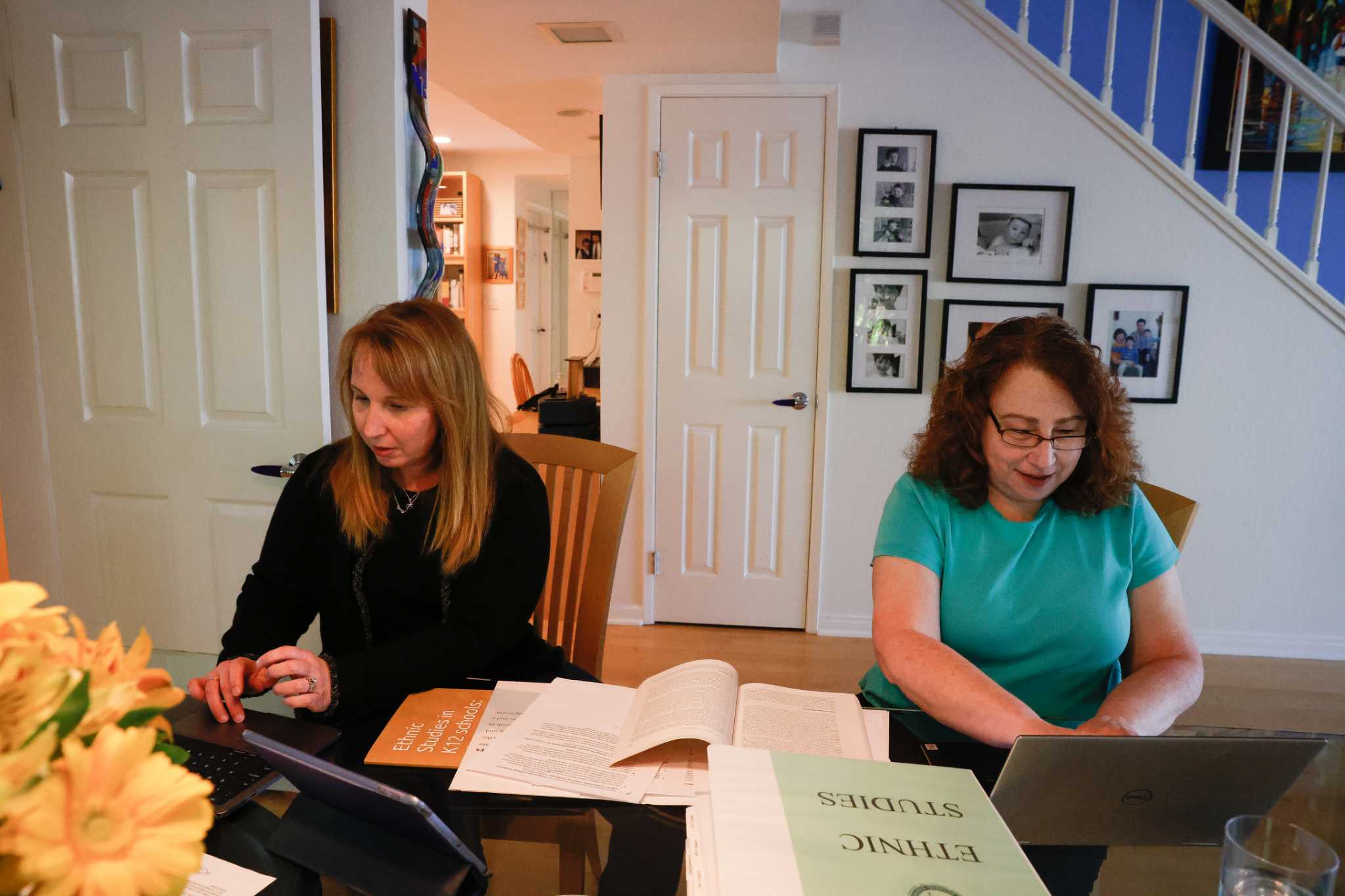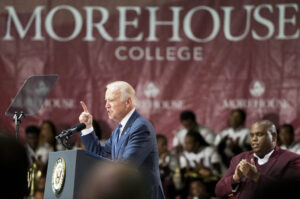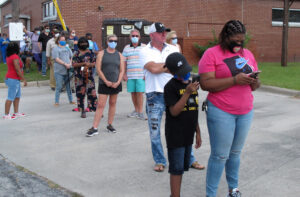The angry emails poured into central office inboxes at San Mateo Union High School District. More than 800 missives from inside and outside the community complained about the district’s ethnic studies courses, saying the curriculum promoted left-wing dogma aimed at turning teens into angry activists.
Superintendent Randall Booker didn’t believe that was true, but told The Chronicle the complaints stemmed from fear and misunderstanding about a course that older generations had never heard of and included topics that were taboo in public schools for decades.
In the wake of the pushback, Booker defended the district’s ethnic studies class at a February school board meeting. He felt the class was important — not just because it’s crucial for students to learn about the past. What he was seeing too frequently in the present — the white supremacy stickers, swastikas and the N-word on campuses and students using bigoted language on social media — alarmed him.
“We are fighting hate in real time,” he told the school board.
To help quell the outrage, the district scheduled a school board study session earlier this month to delve into what is taught in ethnic studies classrooms and how to improve lesson plans. Meanwhile, officials plan to continue to roll out the course across the district.
The controversy in San Mateo over the purpose of ethnic studies and how to teach it is likely just a preview of battles to come across the Bay Area and the state.
“Most of (the students) have not experienced discrimination. When you emphasize that, you are setting in their mind there is discrimination,” said parent Carrie Cavigioli, who is concerned about the ethnic studies courses in San Mateo Union High School District, saying she doesn’t want the courses to focus on who’s oppressing who.
Cavigioli, who describes herself as ethnic Chinese, said that while discrimination exists, the courses place an “overemphasis on everything negative.”
A new state law will require all high school students to take a semester-long course to graduate, starting with the class of 2030, but there is no mandatory curriculum, allowing the districts to develop their own approach.
The legislation reflects research, including a 2021 Stanford University study, showing ethnic studies had a significant positive impact on student outcomes, including increased high school graduation and attendance rates, as well as an increased likelihood of enrolling in college.
Student Adriana Bunac, a Pacifica high school senior, found the ethnic studies she took as a ninth grader enjoyable and informative.
“I learned more about my Filipino culture in that class, and no other class has talked about my ethnicity,” she said, adding racism was also a big topic.
“I liked that we talked about racism and how it was wrong because it taught my peers and I that we did have a voice,” she said. “After the class more people started to use their voice and advocate for those who faced injustices.”
Teacher Jonathan Krupp is looking forward to helping more students feel the same way when he steps into the first ethnic studies classes taught at Pacifica’s Terra Nova High School this fall.
He’s also well aware he’ll be walking into a potential political minefield.
“It’s absolutely essential to creating a new generation of students that will be aware of what’s going on in the world,” he said. “But I can already envision some parents pushing back really, really hard, saying, ‘Don’t you dare think about turning my child into an activist.’ ”
Teachers and administrators across the Bay Area and the country say they feel caught in the middle of a national debate on race, with the potential for protests or the loss of their jobs if they violate policies or laws about what they can say in class.
In Florida, the law bans any class discussions on race that cause students discomfort. In Iowa, where instruction on racial issues is restricted, a recorded conversation caught the district superintendent telling a teacher it was unclear whether teachers could tell students that slavery was wrong.
To a large degree, California has avoided the divisive conversations and restrictive laws about what teachers can say about race or racism in schools. But the ethnic studies requirement is dividing the state, with no consensus on how to teach it and to what end.
While both sides agree that the course should focus on understanding the history of marginalized groups, that’s generally where the similarities end.
On one side are those who see the class as a way to foster pride for young people in their identities and an appreciation for other cultures.
On the other side are groups that believe the course should also focus on the ongoing impact of white supremacy, racism, patriarchy and other versions of oppression, while helping students to transform the world around them.
Elina Kaplan co-founded Alliance for Constructive Ethnic Studies, launching battles, including one in San Mateo, for a course she calls “constructive ethnic studies,” which means the course isn’t politicized or focused on telling students what to think, but how to critically think about racism, white supremacy, colonialism, capitalism, color blindness and other race-related topics.
“I think kids can learn about anything and everything. It’s not about what we teach, it’s how we teach,” Kaplan said. “We are focused on ethnic studies curriculum that is free of ideological agendas, but encourages students to build bridges.”
The lifelong Democrat has also helped organize a network of similar-minded people from across the political spectrum to challenge the use of the “liberated” ethnic studies curriculum in California classrooms, which has more of a focus on oppression, racism and activism and is more like the university-level ethnic studies than what should be in high schools.
Those supporting the liberated ethnic studies model fight back against Cavigioli’s perspective, saying systemic racism and white supremacy are real and students need to face it and address it in their community and across the world.
“The purpose of Ethnic Studies is to eliminate racism and intersectional forms of oppression,” according to the Coalition for Liberated Ethnic Studies, an organization founded by teachers in 2021. “This purpose must be upheld both in and outside of the classroom.”
The liberated ethnic studies supporters say they are the counterweight to right-wing legislators and their base.
“Lawmakers in 42 states have introduced legislation that requires educators to lie to their students about the role of colonialism, white supremacy, and patriarchy in the history of the United States,” wrote Allyson Tintiangco-Cubales, ethnic studies professor at San Francisco State University, along with eight co-authors in a 2022 Convergence Magazine article.
“To achieve racial justice, we must teach about racial injustice — and about the resistance and social movements that have combated these acts of violence for generations,” she said in the piece.
Representatives from the coalition, as well as those from the Liberated Ethnic Studies Model Curriculum Consortium, did not respond to requests for comment about critics’ concerns.
In Orange County, where communities are already choosing their side as they roll out ethnic studies, parent Barbie George doesn’t want her children to feel oppressed, she said.
“I don’t want my little girl to think her best friend is her enemy or her oppressor or bad in some way,” she said.
Such thinking aligns with many across the country who don’t want students to feel guilty or distressed by race-related coursework.
That issue was part of the first statewide debate over how to teach ethnic studies in California as the state Board of Education in 2019 was selecting a state model curriculum for the subject. The initial draft was largely written by university ethnic studies professors and reflected the activist origin of the college-level courses founded at San Francisco State University in the late 1960s.
A backlash was nearly immediate, with critics concerned about the pro-Palestine bent as well as what they considered left-wing dogma. A few years later, following rewrites, the final draft emphasized critical thinking and included multiple points of view.
The curriculum, however, is only a recommendation, with districts and teachers following their own path.
As the state requirement nears, fights continue to erupt at local levels as districts choose a curriculum and write lesson plans. In San Mateo, Booker said the district didn’t adopt the state or liberated curriculum, but rather a version created by district teachers.
Kaplan believes it nonetheless leans toward the “liberated” perspective, citing a lesson plan that includes asking students to expound on why color blindness — a belief that the way to end racism is to ignore racial differences — is harmful.
Instead, she said, it should ask students to discuss perspectives on color blindness, which others say ignores systemic racism.
Kaplan said confronting racism is an important part of ethnic studies.
Booker agrees, given what he continues to see happening on his campuses.
A week ago, an antisemitic message was found in a high school boys’ bathroom, Booker said, yet another distressing public display of bigotry.
But he sees hope for the future, especially among this generation of young people learning about racism and how to address it.
“The students are horrified. They can’t believe this is going on in 2023. They want to take action. They want to mobilize,” he said. “They’re done with this. They’ve had it with hate.”
Reach Jill Tucker: jtucker@sfchronicle.com






